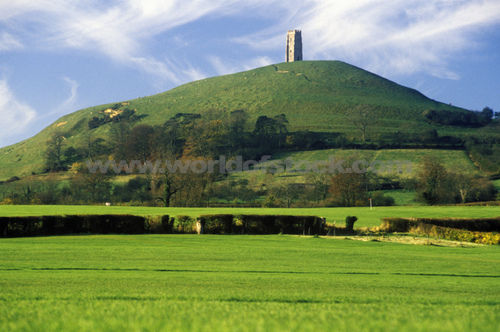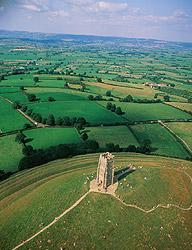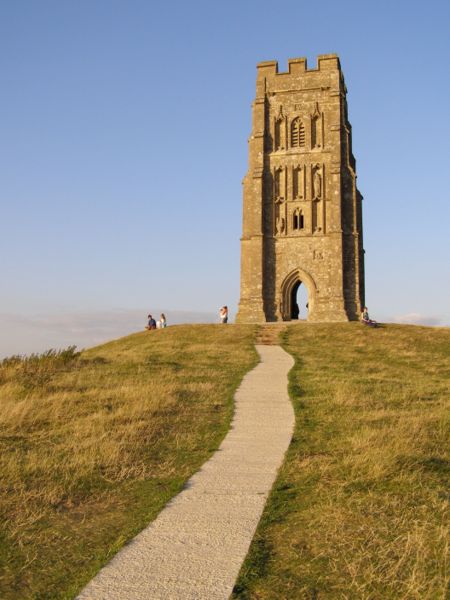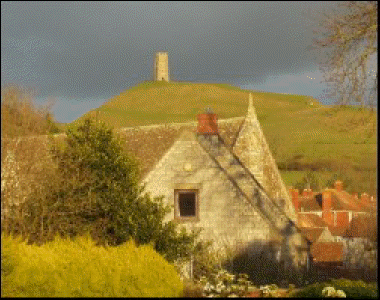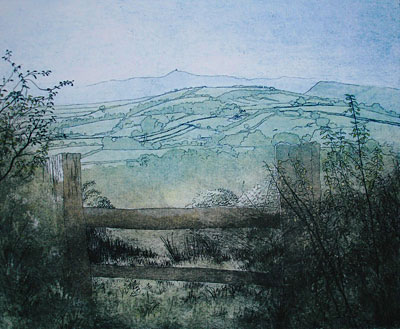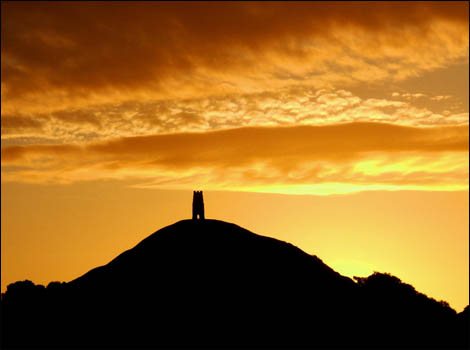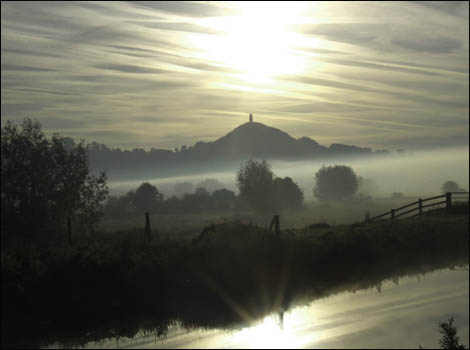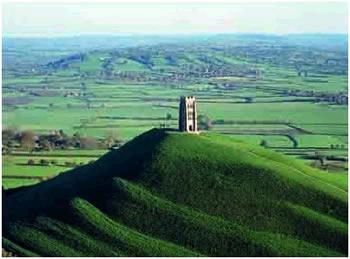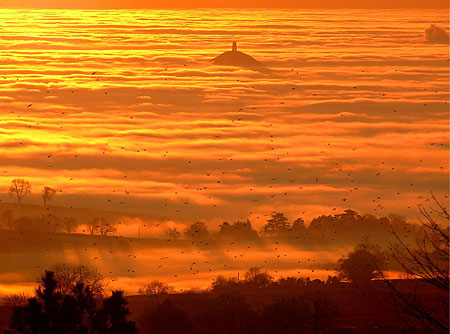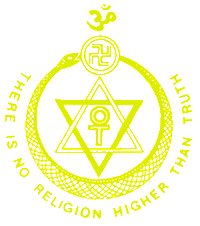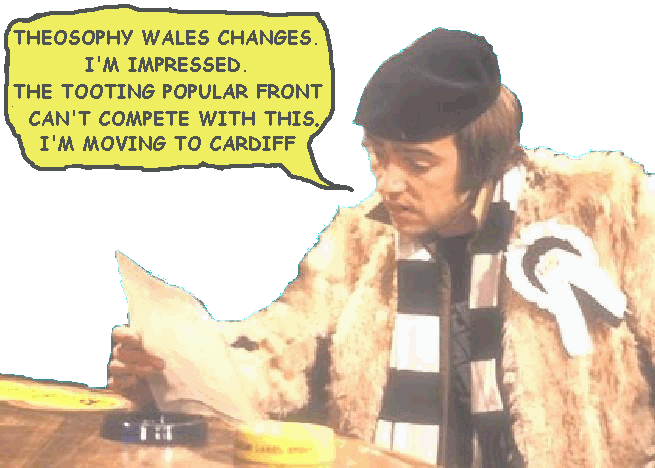Tor
Glastonbury Tor is a hill at Glastonbury, Somerset, England, which
features the roofless St. Michael's Tower. The site is managed by the National
Trust.
Tor is a local word of Celtic origin meaning 'conical hill'. The Tor has
a striking location in the middle of a plain called the Summerland Meadows,
part of the
Ruin of St Michael's Church
Interior of St Michael's ChurchSome Neolithic flint tools recovered from
the top of the Tor show that the site has been visited and perhaps occupied
throughout human prehistory. Excavations on Glastonbury Tor, undertaken by a
team led by Philip Rahtz between 1964 and 1966, revealed evidence of Dark Age
occupation around the later medieval church of St. Michael: postholes, two
hearths including a metalworker's forge, two burials oriented north-south (thus
unlikely to be Christian), fragments of 6th century Mediterranean amphorae
(vases for wine or cooking oil), and a worn hollow bronze head which may have
topped a Saxon staff. The Celtic name of the Tor was "Ynys Wydryn",
or sometimes "Ynys Gutrin", meaning "Isle of Glass". At
this time the plain was flooded, the isle becoming a peninsula at low tide.
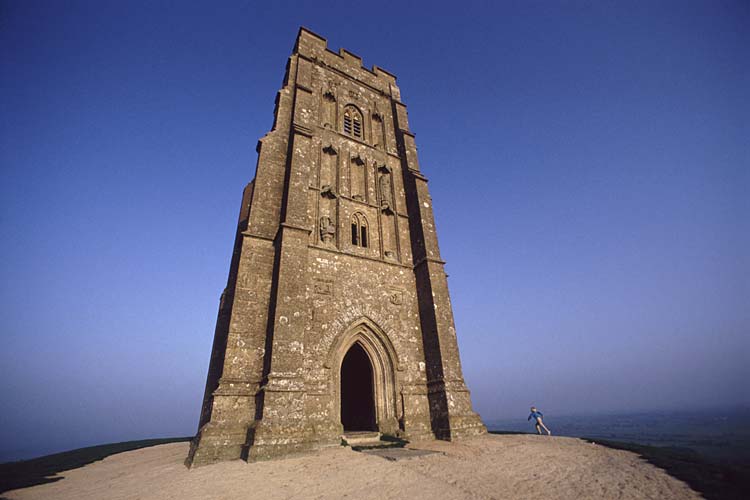
Remains of a 5th century fort have been found on the Tor. This was
replaced by the medieval St. Michael's church that remained until 1275.
According to the British Geological Survey, an earthquake was recorded on
A second church, built in the 1360s, survived until the Dissolution of
the Monasteries in 1539 when the Tor was the place of execution where Richard
Whiting the last Abbot of Glastonbury Abbey was hanged, drawn and quartered
along with two of his monks. The remains of St. Michael's Tower were restored
in modern times. It is a grade I listed building and is managed by the National
Trust.
King Arthur
The Tor has been associated with the name Avalon, and identified, since
the alleged discovery of King Arthur and Queen Guinevere's neatly labelled
coffins in 1191, with the legendary hero King Arthur. Modern archaeology has
revealed a fort, dated to the 5th century.
With the 19th-century resurgence of interest in Celtic mythology, the
Tor became associated with Gwyn ap Nudd, who was first Lord of the Underworld,
and later King of the Fairies. The Tor came to be represented as an entrance to
Annwn or Avalon, the land of the fairies.
A persistent myth of more modern origin is that of the
Christopher Hodapp asserts in his book The Templar Code For Dummies that
Another speculation is that the Tor was reshaped into a spiral maze for
use in religious ritual, incorporating the myth that the Tor was the location
of the underworld king's spiral castle.
Terraces
Terraces on the Tor The seven deep, roughly symmetrical terraces are one
of the Tor's enduring mysteries. A number of possible explanations for them
have been put forward:
Agriculture — many cultures, not least the British farmers of the Middle
Ages have terraced hills to make ploughing for crops easier. Mann, however,
observes that if agriculture had been the reason for the creation of the
terraces, it would be expected that the effort would be concentrated on the
south side, where the sunny conditions would provide a good yield, however it
may be seen that the terraces are equally deep on the north, where there would
be little benefit. Additionally, none of the other slopes of the island have
been terraced, even though the more sheltered locations would provide a greater
return on the labour involved.
Cattle grazing — over long periods of time, cattle grazing can cause
terraces to develop, but these are usually of a much smaller size than those
observed at
Defensive ramparts — Other Iron Age hill forts in the area show evidence
of extensive fortification of the slopes of hills, (for example, South Cadbury
Castle). However, the normal form of these ramparts is that of a bank and ditch
and on the Tor, there is no evidence of this arrangement. Additionally,
Labyrinth — Professor Rahtz felt that the theory that the Tor terraces
formed the remains of a three dimensional labyrinth was "well worth
consideration" (in Mann, 1993). The theory, first put forward by Geoffrey
Russell in 1968, states that the 'classical labyrinth' (Caerdroia), a design
found all over the Neolithic world, can be easily transposed onto the Tor so
that by walking around the terraces one eventually reaches the top in the same
pattern. Evaluating this hypothesis is not easy. A Labyrinth would very likely
place the terraces in the Neolithic era (Rahtz, in Mann, 1993), but given the
amount of occupation since then, there may have been substantial modifications
by farmers and/or monks and conclusive excavations have not been carried out.
Geology
A concrete path to the summit aims to reduce the effects of soil
erosionThe Tor consists of layers of clay and blue lias strata (Jurassic
sandstone) with a cap of hard midford sandstone, whose resistance to erosion
compared to the lower layers is responsible for its height. The iron-rich
waters of Chalice Well, a spring, have been flowing out as an artesian well for
millions of years, impregnating the sandstone round it with iron oxides that
have reinforced it. Iron-rich but oxygen-poor water in the aquifer carries
dissolved Iron (II) "ferrous" iron, but as the water surfaces and its
oxygen content rises, the oxidized Iron (III) "ferric" iron drops out
as insoluble "rusty" oxides that bind to the surrounding stone,
hardening it. As the surrounding soft sandstone has eroded away,
The Theosophy Cardiff Guide to
The Theosophy Cardiff Guide to
The Terraced Maze of Glastonbury Tor
The Grave of King Arthur & Guinevere
Glastonbury and Joseph of Arimathea
_____________________
Arthurian & Grail Links
Completing the
Quest for Wholeness
Telling the Story
of our Times
Diana Durham applies concepts from
Arthurian Legend
to leadership
strategies in the modern era
Perform Your Own Arthurian Legend
__________________________________
_____________________________
Theosophy
Links
Cardiff Theosophical Society meetings are informal
and there’s always a cup of tea afterwards
The Cardiff Theosophical Society Website
The National Wales Theosophy Website
Bangor, Cardiff, Conwy & Swansea
If
you run a Theosophy Group, please feel free
to
use any of the material on this site
The Most Basic Theosophy
Website in the Universe
A quick overview of Theosophy
and the Theosophical Society
If you run a Theosophy Group you
can use this as an introductory handout.
Theosophy Cardiff’s Instant Guide
Theosophical Movement in Wales
as it separates into independent
groups that run do their own show
One liners and quick explanations
H P Blavatsky is usually the only
Theosophist that most people have ever
heard of. Let’s put that right
The Voice of the Silence Website
An Independent Theosophical Republic
Links to Free Online Theosophy
Study Resources; Courses, Writings,
The main criteria for the inclusion of
links on this site is that they have some
relationship (however tenuous) to Theosophy
and are lightweight, amusing or entertaining.
Topics include Quantum Theory and Socks,
Dick Dastardly and Legendary Blues Singers.
A selection of articles on Reincarnation
Provided in response to the large
number of enquiries we receive at
Cardiff Theosophical Society on this subject
The Voice of the Silence Website
This is for everyone, you don’t have to live
in Wales to make good use of this Website
The Theosophy Cardiff Guide to
The Theosophy Cardiff Guide to
No
Aardvarks were harmed in the
__________________
& of course
you don’t need to live in Wales
to take advantage of this guide
_____________________
Concerns about
the fate of the wildlife as
Tekels Park is to
be Sold to a Developer
Concerns are
raised about the fate of the wildlife as
The Spiritual
Retreat, Tekels Park in Camberley,
Surrey, England
is to be sold to a developer.
Tekels Park is a
50 acre woodland park, purchased
for the Adyar Theosophical Society in England
in 1929.
In addition to
concern about the park, many are
worried about the future of the Tekels Park
Deer
as they are not a
protected species.
Anyone planning a
“Spiritual” stay at the
Tekels Park Guest
House should be aware of the sale.
Theosophy talks
of a compassionate attitude
to animals and
the sale of the Tekels Park
sanctuary for
wildlife to a developer has
Future of Tekels Park Badgers in Doubt
Party On! Tekels Park Theosophy NOT
St Francis Church at Tekels Park
Tekels Park & the Loch Ness Monster
A Satirical view of
the sale of Tekels Park
in Camberley,
Surrey to a developer
The Toff’s Guide to the Sale of Tekels Park
What the men in top
hats have to
say about the sale
of Tekels Park
____________________
The
Theosophy Cardiff Guide to
Pendle Hill, Lancashire, England.
____________________
Within the British Isles, The
Adyar Theosophical Society is the
largest Theosophical Body and has Groups in;
Bangor*Basingstoke*Billericay*Birmingham*Blackburn*Bolton*Bournemouth
Bradford*Bristol*Camberley*Cardiff*Chester*Conwy*Coventry*Dundee*Edinburgh
Folkstone*Glasgow*Grimsby*Inverness*Isle of
Man*Lancaster*Leeds*Leicester
Letchworth*London*Manchester*Merseyside*Middlesborough*Newcastle
upon Tyne
North Devon*Northampton*Northern Ireland*Norwich*Nottingham
Perth*Republic of
Ireland*Sidmouth*Southport*Sussex*Swansea*Torbay
Tunbridge Wells*Wallasey*Warrington*Wembley*Winchester*Worthing
The Spiritual Home of Urban Theosophy
The Earth Base for Evolutionary Theosophy
A B C D EFG H IJ KL M N OP QR S T UV WXYZ
Complete Theosophical Glossary in Plain Text Format
1.22MB
Quick Explanations with Links to More Detailed Info
What is Theosophy ? Theosophy Defined (More Detail)
Three Fundamental Propositions Key Concepts of Theosophy
Cosmogenesis
Anthropogenesis
Root Races
Karma
Ascended Masters After Death States Reincarnation
The Seven Principles of Man Helena Petrovna Blavatsky
Colonel Henry Steel Olcott William Quan Judge
The Start of the Theosophical Society
History of the Theosophical Society
Theosophical Society Presidents
History of the Theosophical Society in Wales
The Three Objectives of the Theosophical Society
Explanation of the Theosophical Society Emblem
Glossaries of Theosophical Terms
An Outstanding Introduction to Theosophy
By a student of Katherine Tingley
Elementary Theosophy Who is the Man? Body and Soul
Body, Soul and Spirit Reincarnation Karma
What Theosophy Is From the Absolute to Man
The Formation of a Solar System The Evolution of Life
The Constitution of Man After Death Reincarnation
The Purpose of Life The Planetary Chains
The Result of Theosophical Study
An Outline of Theosophy
Charles Webster Leadbeater
Theosophy - What it is How is it Known? The Method of Observation
General Principles The Three Great Truths The Deity
Advantage Gained from this Knowledge The Divine Scheme
The Constitution of Man The True Man Reincarnation
The Wider Outlook Death Man’s Past and Future
Cause and Effect What Theosophy does for us
Try these if you are looking for a local
Theosophy Group or Centre
UK Listing of Theosophical Groups
Please tell us about your UK Theosophy Group
___________________
into
categories and presented according to relevance of website.
Web
Directory - Add Link - Submit Article - Online Store - Forum
______________________
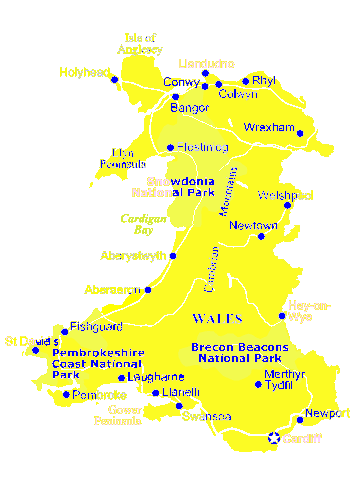
General pages about Wales, Welsh History
and The History of Theosophy in Wales
Wales is a
Principality within the United Kingdom and has an eastern
border with
England. The land area is just over 8,000 square miles.
Snowdon in North
Wales is the highest mountain at 3,650 feet.
The coastline is
almost 750 miles long. The population of Wales
as at the 2001 census is 2,946,200.
________________
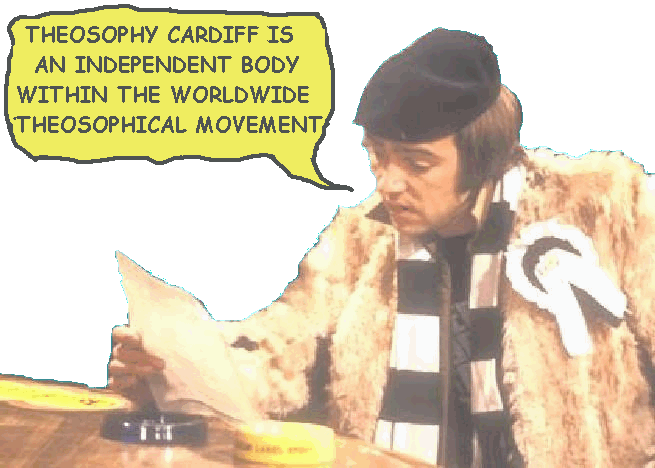
Bangor Conwy
& Swansea Lodges are members
of the Welsh
Regional Association (Formed 1993).
Theosophy Cardiff
separated from the Welsh Regional
Association in
March 2008 and became an independent
body within the Theosophical Movement in March 2010
High Drama & Worldwide Confusion
as Theosophy Cardiff Separates from the
Welsh Regional Association (formed 1993)
Theosophy Cardiff cancels its Affiliation
to the Adyar Based Theosophical Society
Cardiff, Wales, UK, CF24 – 1DL
